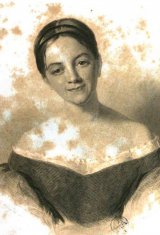Analysis of Fragment - Is not this grove
Letitia Elizabeth Landon 1802 (Chelsea) – 1838 (Cape Coast)
Is not this grove
A scene of pensive loveliness—the gleam
Of Dian's gentle ray falls on the trees,
And piercing thro’ the gloom, seems like the smile
That pity gives to cheer the brow of grief:
The turf has caught a silvery hue of light
Broken by shadows, where'er the branching oak
Rears its dark shade, or where the aspen waves
Its trembling leaves. The breeze is murmuring by
Fraught with sweet sighs of flowers and the song
Of sorrow, that the nightingale pours forth,
Like the soft dirge of love.
There is oft told
A melancholy record of this grove—
It was time once the haunt of young affection—
And now seems hallowed by the tender vows
That erst were breathed here.
Sad is the tale
That tells of blighted feelings, hopes destroyed;
But love is like the rose, so many ills
Assail it in the bud—the cankering blast,
The frost of winter and the summer storm,
All bow it down; rarely the blossom comes
To full maturity; but there is nought
Sinks with so chill a breath as Faithlessness,—
As she could tell whose loveliness yet lives
In village legends. Often, at this hour
Of lonely beauty, would she list the tale
Of tenderness, and hearken to the vows
Of one more dear than life unto her soul:
He twined him round a heart which beat with all
The deep devotedness of early love—
Then left her, careless of the passion which
He had awakened into wretchedness:
The blight which withered all the blossoms love
Had fondly cherish'd, wither'd to the heart
Which gave them birth. Her sorrow had no voice,
Save in her faded beauty; for she looked
A melancholy broken-hearted girl.
She was so changed, the soft carnation cloud
Once mantling o'er her cheek like that which eve
Hangs o'er the sky, glowing with roseate hue
Had faded into paleness, broken by
Bright burning blushes, torches of the tomb.
There was such sadness, even in her smiles,
And such a look of utter hopelessness
Dwelt in her soft blue eye—a form so frail,
So delicate, scarce like a thing of earth—
‘Twas sad to gaze upon a brow so fair,
And see it traced with such a tale of woe—
To think that one so young and beautiful
Was wasting to the grave.
Within yon bower,
Of honey suckle and the snowy wealth
The mountain ash puts forth to welcome spring,
Her form was found reclined upon a bank,
Where nature's sweet unnurtur'd children bloom.
One white arm lay beneath her drooping head,
While her bright tresses twin‘d their sunny wreath
Around the polish’d ivory; there was not
A tinge of colour mantling o’er her lovely face;
’Twas like to marble, where the sculptor's skill
Has traced each charm of beauty but the blush.
Serenity so sweet sat on her brow;
So soft a smile yet hover'd on her lips,
At first they thought 'twas sleep—and sleep it was—
The cold long rest of death.
| Scheme | Text too long |
|---|---|
| Poetic Form | |
| Metre | 1111 01110101 111011101 0101011101 1101110111 01110100111 1011100101 1111110101 110010111001 1111110001 1101010011 101111 1111 010001111 11110111010 0111010101 11011 1101 1111010101 1111011101 011001011 0111000101 1111100101 1101001111 11110111 11111111 01010101110 1101011101 110001101 1111111001 1111011111 0111101 1101010101 11010011 0111010101 1101010101 1111010111 1001010111 010010101 1111010101 1110011111 110011011001 110011101 1101010101 1111010001 0101110100 1001110111 1100110111 1111010111 0111110111 1111110100 110101 01110 1101000101 0101111101 0111010101 11011101 1111010101 1011011101 0101100111 0111110101 111101011 1111110101 0100111101 1101110101 1111110111 011111 1 |
| Closest metre | Iambic pentameter |
| Characters | 2,772 |
| Words | 501 |
| Sentences | 12 |
| Stanzas | 1 |
| Stanza Lengths | 68 |
| Lines Amount | 68 |
| Letters per line (avg) | 32 |
| Words per line (avg) | 7 |
| Letters per stanza (avg) | 2,165 |
| Words per stanza (avg) | 500 |
Font size:
Submitted by Madeleine Quinn on October 20, 2019
Modified by Madeleine Quinn on October 23, 2019
- 2:33 min read
- 59 Views
Citation
Use the citation below to add this poem analysis to your bibliography:
Style:MLAChicagoAPA
"Fragment - Is not this grove" Poetry.com. STANDS4 LLC, 2024. Web. 27 May 2024. <https://www.poetry.com/poem-analysis/51698/fragment---is-not-this-grove>.


Discuss this Letitia Elizabeth Landon poem analysis with the community:
Report Comment
We're doing our best to make sure our content is useful, accurate and safe.
If by any chance you spot an inappropriate comment while navigating through our website please use this form to let us know, and we'll take care of it shortly.
Attachment
You need to be logged in to favorite.
Log In